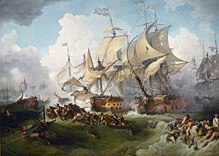
Back الأول من يونيو المجيد Arabic Bitva Slavného 1. června Czech Seeschlacht vom 1. Juni 1794 German Glorioso primero de junio Spanish Bataille du 13 prairial an II French Ushanti csata Hungarian Glorioza unesma di junio IO Glorioso Primo di Giugno Italian 栄光の6月1日 Japanese 영광스러운 6월 1일 Korean
| Glorious First of June | |||||||
|---|---|---|---|---|---|---|---|
| Part of the naval operations during the War of the First Coalition | |||||||
 Lord Howe's action, or the Glorious First of June, Philip James de Loutherbourg | |||||||
| |||||||
| Belligerents | |||||||
|
|
| ||||||
| Commanders and leaders | |||||||
|
|
| ||||||
| Strength | |||||||
|
| ||||||
| Casualties and losses | |||||||
| 1,200 killed and wounded |
| ||||||
The Glorious First of June (1 June 1794), also known as the Fourth Battle of Ushant, (known in France as the Bataille du 13 prairial an 2 or Combat de Prairial)[b] was the first and largest fleet action of the naval conflict between the Kingdom of Great Britain and the First French Republic during the French Revolutionary Wars.
The action was the culmination of a campaign that had criss-crossed the Bay of Biscay over the previous month in which both sides had captured numerous merchant ships and minor warships and had engaged in two partial, but inconclusive, fleet actions. The British Channel Fleet under Admiral Lord Howe attempted to prevent the passage of a vital French grain convoy from the United States, which was protected by the French Atlantic Fleet, commanded by Rear-Admiral Villaret-Joyeuse. The two forces clashed in the Atlantic Ocean, some 400 nautical miles (700 km) west of the French island of Ushant on 1 June 1794.
During the battle, Howe defied naval convention by ordering his fleet to turn towards the French and for each of his vessels to rake and engage their immediate opponent. This unexpected order was not understood by all of his captains, and as a result, his attack was more piecemeal than he intended. Nevertheless, his ships inflicted a severe tactical defeat on the French fleet. In the aftermath of the battle both fleets were left shattered; in no condition for further combat, Howe and Villaret returned to their home ports. Despite losing seven of his ships of the line, Villaret had bought enough time for the French grain convoy to reach safety unimpeded by Howe's fleet, securing a strategic success. However, he was also forced to withdraw his battle fleet back to port, leaving the British free to conduct a campaign of blockade for the remainder of the war. In the immediate aftermath, both sides claimed victory and the outcome of the battle was seized upon by the press of both nations as a demonstration of the prowess and bravery of their respective navies.
The Glorious First of June demonstrated a number of the major problems inherent in the French and British navies at the start of the Revolutionary Wars. Both admirals were faced with disobedience from their captains, along with ill-discipline and poor training among their shorthanded crews, and they failed to control their fleets effectively during the height of the combat.
Cite error: There are <ref group=lower-alpha> tags or {{efn}} templates on this page, but the references will not show without a {{reflist|group=lower-alpha}} template or {{notelist}} template (see the help page).
- ^ Padfield 2000, p. 13.